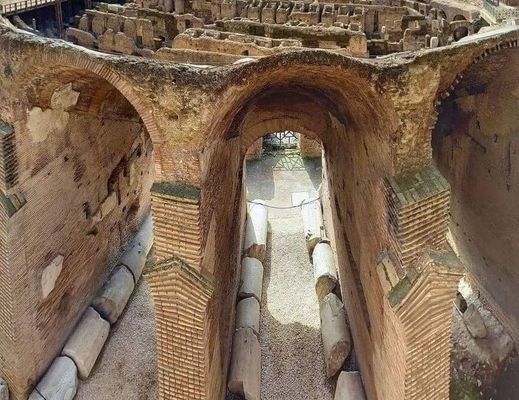
The Colosseum, a legendary emblem of ancient Rome, showcases the magnificence and intricacy of Roman architectural and engineering achievements.
This massive amphitheater was built during the reign of the Flavian emperors.
It was built on the grounds of what was once Emperor Nero’s opulent Golden House.
The Colosseum stands today as not only an incredible feat of ancient engineering but also a vibrant emblem of Rome’s lasting heritage.

How was it built?
The Colosseum’s construction began between 70 and 72 CE during the reign of Emperor Vespasian, who established the Flavian dynasty.
It was constructed on the location of an artificial lake that formed part of Nero’s extravagant Golden House.
Did you like this Article?
Vespasian, having come from humble origins, aimed to substitute Nero’s extravagant private lifestyle with a magnificent public amphitheater.

The Colosseum was inaugurated in 80 CE by Titus, the son of Vespasian, during a lavish ceremony that spanned 100 days and featured a range of games and performances.
Domitian, who succeeded Vespasian, finished the construction in 82 CE by adding the topmost level.

Architectural Features
The Colosseum stands independently, in contrast to earlier amphitheaters that were usually constructed into hillsides for extra stability.
The structure spans 620 by 513 feet (189 by 156 meters) and consists of three levels of arches upheld by columns designed in Doric, Ionic, and Corinthian styles.

The primary structure of the Colosseum consists of travertine stone, with other areas constructed from volcanic tufa and concrete.
The amphitheater had the capacity to accommodate 50,000 spectators, all shielded from the sun by a large retractable velarium.
Masts rising from the attic level required hundreds of Roman sailors to handle the rigging of this awning.

What was the Roman Colosseum used for?
The Colosseum gained fame for its impressive spectacles, such as gladiator fights, animal hunts, and even staged naval battles.
These events aimed to captivate the audience while showcasing the might and engineering prowess of Rome.
Despite common belief, there is no concrete evidence that early Christians were martyred in this location.

During the Middle Ages, the Colosseum served as a church and subsequently became a fortress for notable Roman families, including the Frangipane and Annibaldi.
It experienced significant destruction due to lightning strikes, earthquakes, and acts of vandalism.
For more than a thousand years, it served as a quarry, with a significant amount of its marble extracted for use in other structures.
The Hypogeum: The Underground of the Colosseum
Underneath the Colosseum is the Hypogeum, an intricate system of tunnels and chambers that was essential to the ancient Roman games.
The term “Hypogeum” translates to “underground,” which accurately reflects this concealed section of the Colosseum.

Structure and Design
The Hypogeum consisted of two primary levels of tunnels and corridors.
It included 32 enclosures for animals, along with spaces designated for gladiators and entertainers.
This subterranean labyrinth was created to enhance the thrill and drama of the games.
Vertical Shafts and Trapdoors
A remarkable aspect of the Hypogeum is its 80 vertical shafts.
These shafts enabled the rapid elevation of animals, scenery, and gladiators to the arena floor, delivering unexpected thrills for the spectators.
The arena floor featured 36 trapdoors designed for special effects, allowing animals or gladiators to suddenly emerge.

Housing the Beasts
The Hypogeum contained a variety of animals for the performances, including lions, tigers, bears, elephants, and even crocodiles.
These animals were confined to cramped quarters until it was time for them to enter the arena and confront gladiators or other creatures in brutal fights.

Gladiators and Performers
For the gladiators, the Hypogeum was a waiting area.
They remained in poorly lit rooms, getting ready for their battles.
This subterranean realm was the final location they occupied before stepping into the arena, frequently to battle for their survival.

Engineering Marvel
The design of the Hypogeum was remarkably sophisticated for its era.
It employed a network of pulleys, winches, and lifts to control the intricate performances with remarkable accuracy.
This highlighted the remarkable abilities of Roman architects.

Preservation
The serious preservation efforts for the Colosseum started in the 19th century, led by Pope Pius VIII.
The 1990s featured major restoration efforts focused on preserving this iconic structure.
In recent years, the Colosseum has seen a major restoration plan that has been well-received.
The Italian government has dedicated substantial resources to renovating the arena floor, with the goal of bringing the amphitheater back to its original splendor.
This project involves the installation of a new retractable floor that mimics the original wooden and sand surfaces from ancient times.

Culture Minister Dario Franceschini has announced a restoration project with a budget of approximately €18.5 million, which is about $20.2 million USD.
The aim is to restore the arena’s historical appearance while ensuring it is equipped for contemporary events such as concerts and theater performances.
The newly designed retractable floor will aid in safeguarding the ancient underground tunnels, or hypogeum, from environmental damage.

The hypogeum consisted of a complex network of tunnels and rooms located beneath the arena floor, serving as quarters for gladiators, animals, and stage equipment.
The updated floor will include replicas of the trapdoors and lifts that were used for dramatic entrances in ancient games.

The restoration project, funded by the Italian fashion brand Tod’s, commenced in 2018 and includes the efforts of 81 archaeologists and specialists.
The restoration of the Colosseum’s underground section has been completed.
Since July 2023, the underground area is completely accessible to the public, enabling visitors to discover the complex tunnels and rooms that housed gladiators and animals prior to their fights in the arena.

Today, the Colosseum attracts nearly seven million visitors annually and serves as a major tourist destination.
It features rotating exhibitions that explore the culture and history of ancient Rome, consistently linking contemporary audiences to the magnificence of the past.



